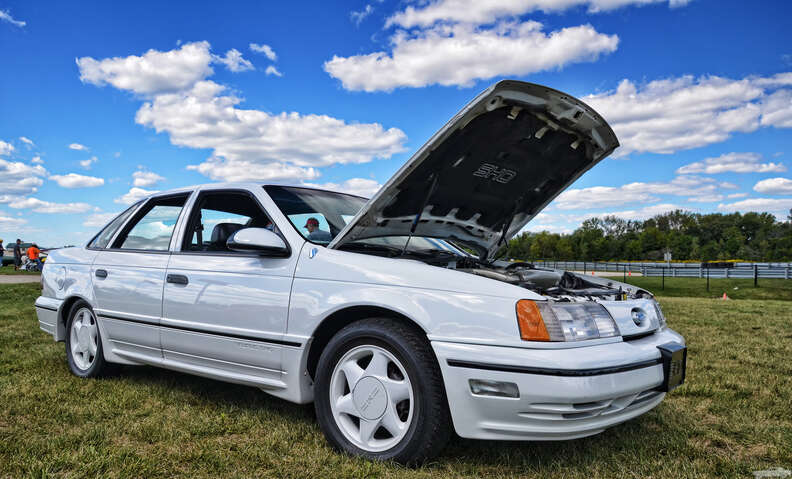
Larry was astonished at the originality of the 1969 Ford Cobra when he first saw it. It was in excellent condition with its original Raven Black paint finish. It was in need of a new paint job, but otherwise, the car was a great deal more original than Larry thought. This Cobra had lived its whole life in Wisconsin, and it had never been driven since new. Larry had the simple idea of bringing it up to the next level.
1969 Ford Cobra
This 1969 Ford Cobra car is a reference-quality muscle car and an investment grade vehicle. It is the perfect addition to any collection. It's available for sale now from National Muscle Cars. The following configurations are available: R, R, and RS. The engine can be taken out of the car, and the transmission or transaxle installed in front.
This is the most powerful Ford car of 1969. The Cobra transmission is four-speed and produces 335 horsepower. The car also features competition suspension. Motor Trend measured the Cobra's four-speed speed and determined that it could complete the quarter-mile in 14.5 seconds. The Cobra's Ram Air system ensured that the driver was well-placed, so there wasn't any motion sickness. It is capable of turning sharp corners, but can also become hairy.

1993 Ford Mustang SVT Cobra
This 1993 Ford Mustang SVT Cobra limited edition was an exclusive production model of the Foxbody sports car. It was equipped with the 5.0-liter V8 engine which is tuned for increased power. The car's original rating was 235 horsepower with 280 lb-ft of torque. SVT tuning based its performance off the Mustang GT. Therefore, the car's head cylinders were replaced with GT40 components. The engine also had modified intake manifolds and camshafts. It also had vented disk brakes.
The engine was powered from a 302CI, V8 engine producing 235 horsepower. It came with GT-40 Cast Iron heads, which had larger intake port and valve designs. These heads were equipped with GT-40 lower intakes manifolds. They also had a special tubular cast aluminium upper intake based on the GT-40. The GT-40 manifold diverted air into a series of rectangular ports. The Mustang Cobra's throttle body was also larger than H.O. spec engines.
1999-2004 Ford Mustang SVT Cobra
SVT was offering a performance convertible, the Ford Mustang SVT Cobra, from 1999 to 2004. The same V6 engine was used, but it was modified to improve performance and handling. Cobra was also equipped with an aluminum flywheel. It featured a modified suspension that allowed for individual damping rates. This car's suspension system featured forged alloy wheels with 245/45ZR-17 BFGoodrich Comp T/A tires. The car's distinctive sound began with a low growl at moderate cornering speeds, and then grew to a deep howling at maximum performance.
SVT engineers were able to remove 50 pounds of weight from the car's front end. Twenty percent of this weight is from the engine. Six pounds have been removed from Cobra's coil–on-plug indirect ignition system. The new Mustang SVT Cobra model has a 55/45 forward-to-aft ratio. This is approximately one-foot shorter than its predecessor. The new SVT Cobra weighs 110 more than the previous model.

2010 Ford Mustang Cobra Jet
Ford Mustang Cobra Jet, a high-performance supercar, debuted in 2008. This supercar is in its fourth generation and has received a number of upgrades to improve its performance. Cobra Jet 2010 features a new fuel-system that uses a return type system in the trunk. The intercooler coolant tank has been replaced with aluminum, which increases its capacity and withstands pressurization better. The supercar also features fans and line lock, which disables the rear brakes during a burnout.
The 2010 Cobra Jet started out as a white Mustang. Watson Engineering, a specialist in performance cars, then installed a cage. It also receives a NHRA-legal rear seats delete panel, firewall, transmission access panels, and a firewall. It is then returned to AAI where it gets its new Cobra Jet performance name. The Cobra Jet's engine, suspension and transmission are modified to produce a higher horsepower than its V6 counterpart.
FAQ
What are the different types of jobs available in car mechanic?
Car mechanics can find work in three areas:
-
Automotive repair shops
-
Dealerships
-
Independent garages
Automotive repair shops
This is where most people consider becoming a mechanic. This is the best way to get started. Either you can work in a shop that is owned by another person or start your own business.
If you decide to work at a shop, you'll need to apply to join a union. After being accepted into the union, the union will provide training.
You'll be ready for work once you have completed the training.
Registering with the government is required if you intend to open a garage. After you register, you will be required to meet specific standards.
After you register, you will be granted a license for your garage to operate.
Your license allows you to sell spare parts and make minor repairs. It will not allow you to repair major engine problems.
As well as selling spare parts you will need to offer advice and direction to customers.
Dealership jobs
Most dealerships employ mechanics who can specialize in a particular area of the car. For example, they might only deal with brakes or only replace tires.
However, some dealerships also hire general mechanics who can handle all aspects of car repairs.
These positions often require applicants that they undergo special training before being allowed work. This allows employers to select the most qualified candidates for their roles.
Some dealerships hire students straight out of college. These graduates are familiar with the fundamentals of mechanical engineering so they can easily learn about cars.
Independent garages
Independent garages don’t have to be associated with any particular dealer. Instead, independent garages tend to concentrate on providing high-quality services.
Independent garages are not associated with any companies so they can afford higher wages. This makes them generally more well-paid than jobs at dealerships.
However, independent garages do not necessarily offer better workplaces. Many owners prefer to run their businesses themselves rather than delegate responsibility to employees.
So you may find yourself working long hours without having any say over what happens during the day.
You should also expect to earn lower wages than if you were employed at a dealership.
You can switch jobs easily. You can switch jobs easily if you are interested in working at a dealership. Simply ask your employer if they would be open to hiring you as a mechanic.
Alternatively, if you'd like to work at an independent garage, then you could try applying directly to the owner of the garage.
Unfortunately, finding a new job can be difficult. There are plenty of other factors that influence how much you earn.
It could be the type and cost of labor you use to repair your vehicle.
What is the difference?
They are both similar, but not identical. An automotive technician maintains cars, while a mechanic repairs them.
A mechanic must be skilled in manual dexterity and able to complete simple tasks quickly. They must also be able to diagnose problems accurately and repair them effectively.
An automotive technician is required to have more technical knowledge than a mechanic. They must be capable of reading blueprints and using tools such as drills, wrenches, etc.
They should be able safely to perform complex procedures. They should also be familiarized with the different types of engines as well as electrical systems.
They should also be able understand how different parts interact.
The result is that a mechanic often earns less than an auto technician. Both careers have many options.
Is it hard to get a job working as an auto mechanic?
It can be done. Many garages list their vacancies online. Many people simply apply for the fun of it. If you want to get your foot in the door, you should try applying for a few places and see if they accept student applications. You could also ask your family and friends if they know anyone in the industry. You might be able to refer someone.
Statistics
- According to the BLS, the median annual salary for automotive service technicians and mechanics in the United States was $44,050 in May 2020. (uti.edu)
- 52% of Mechanics in the United States think their salaries are enough for the cost of living in their area. (indeed.com)
- According to the BLS, total auto technician employment is expected to exceed 705,000 by 2030. (uti.edu)
External Links
How To
How to become an Automotive Technician
An automotive technician provides repair services and maintenance to vehicles. He/she works in car dealerships as well as auto shops, garages, and service centers. Customers can rely on him/her to fix their cars, trucks and motorcycles. An automotive technician must have the ability to quickly diagnose and fix problems.
An associate degree from a vocational school is required for anyone who wishes to become an automotive technician. After completing this program, he/she will need to pass the National Institute for Automotive Service Excellence's (ASE) certification exam. ASE stands for American Society of Mechanical Engineers. There are two parts to the ASE certification exam. One section tests knowledge of mechanical components, while the other section tests skills in practical areas. To take the test, you must visit one of the approved testing locations. These testing sites can be found online and through your local dealer.
Before becoming an automotive technician, a candidate must pass the test. It varies depending on the location of the applicant. Some states require that applicants attend a training class, while others allow them freedom to study at their own pace. Some states require technicians to be licensed immediately upon receiving their license. Other states wait until they have been employed as automotive technicians for at least six month.
Apply to your local dealership to become an automotive technician. Most new employees begin as apprentices once they are hired. Apprenticeships last for three years. The apprenticeship program teaches students how to change oil, adjust brakes, replace tires, clean spark plugs, inspect engine compartments, and perform routine maintenance. Advanced repairs can be done by some students, including replacing shocks, installing air filters and repairing engines. Many schools offer classes during regular hours. Some schools also offer evening classes when needed.
Once a student finishes his/her apprenticeship, it is possible to become a Journeyman. Journeymen usually spend four to five year learning how to install major systems like transmissions, differentials steering gear, suspensions, drive shafts, and steering gear. They also learn to perform complex repairs, such as remanufacturing engines, rebuilding transmissions, and troubleshooting electrical components. Many employers prefer to hire Journeymen because they understand the job well.
Candidates who pass the required exams are eligible for a license. According to Bureau of Labor Statistics (2010), almost 1.7million automotive mechanic jobs were on the market. That number was expected to grow by 18 percent from 2009 to 2020. If a candidate decides to open his/her own shop, he/she should prepare to invest many thousands of dollars in equipment and supplies.
The salary for an automotive technician depends on several factors, including the type of employer, location, education level, and experience. A jobless person can expect to make $20,000 per year. A person with only a high-school diploma could make around $21,000 annually. Those with an associate's degree earned approximately $24,000 per year. Technicians with bachelor's degrees earned about $27,000 per year. And those with master's degrees made around $32,000 per year. Salary increases are common so professionals who make less than $30,000 a year could realistically expect to earn $40,000 over the next few years.